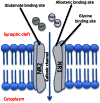NMDA Receptor Activity in Neuropsychiatric Disorders
- PMID: 23772215
- PMCID: PMC3677126
- DOI: 10.3389/fpsyt.2013.00052
NMDA Receptor Activity in Neuropsychiatric Disorders
Abstract
N-Methyl-d-aspartate (NMDA) receptors play a variety of physiologic roles and their proper signaling is essential for cellular homeostasis. Any disruption in this pathway, leading to either enhanced or decreased activity, may result in the manifestation of neuropsychiatric pathologies such as schizophrenia, mood disorders, substance induced psychosis, Huntington's disease, Alzheimer's disease, and neuropsychiatric systemic lupus erythematosus. Here, we explore the notion that the overlap in activity of at least one biochemical pathway, the NMDA receptor pathway, may be the link to understanding the overlap in psychotic symptoms between diseases. This review intends to present a broad overview of those neuropsychiatric disorders for which alternations in NMDA receptor activity is prominent thus suggesting that continued direction of pharmaceutical intervention to this pathway may present a viable option for managing symptoms.
Keywords: Alzheimer’s disease; Huntington’s disease; NMDA; mood disorders; neuropsychiatric systemic lupus erythematosus; psychiatry; schizophrenia; substance induced psychosis.
Figures
Similar articles
-
NMDA Receptors: Distribution, Role, and Insights into Neuropsychiatric Disorders.Pharmaceuticals (Basel). 2024 Sep 25;17(10):1265. doi: 10.3390/ph17101265. Pharmaceuticals (Basel). 2024. PMID: 39458906 Free PMC article. Review.
-
NMDA agonists and antagonists as probes of glutamatergic dysfunction and pharmacotherapies in neuropsychiatric disorders.Harv Rev Psychiatry. 1999 Sep-Oct;7(3):125-43. Harv Rev Psychiatry. 1999. PMID: 10483932 Review.
-
Anti-NMDA receptor encephalitis presenting as postpartum psychosis-a clinical description and review.Arch Womens Ment Health. 2018 Aug;21(4):465-469. doi: 10.1007/s00737-018-0816-3. Epub 2018 Feb 7. Arch Womens Ment Health. 2018. PMID: 29417305 Review.
-
Huntington's disease: Managing neuropsychiatric symptoms in Huntington's disease.Australas Psychiatry. 2018 Aug;26(4):376-380. doi: 10.1177/1039856218766120. Epub 2018 Apr 24. Australas Psychiatry. 2018. PMID: 29687724 Review.
-
N-methyl-d-aspartate glutamate receptor (NMDA-R) antibodies in mild cognitive impairment and dementias.Neurosci Res. 2014 Aug;85:58-64. doi: 10.1016/j.neures.2014.06.002. Epub 2014 Jun 25. Neurosci Res. 2014. PMID: 24973618
Cited by
-
Effects of sodium benzoate on cognitive function in neuropsychiatric disorders: a systematic review and meta-analysis.Front Psychiatry. 2024 Sep 9;15:1370431. doi: 10.3389/fpsyt.2024.1370431. eCollection 2024. Front Psychiatry. 2024. PMID: 39315325 Free PMC article.
-
Enhancing of cerebral Abeta clearance by modulation of ABC transporter expression: a review of experimental approaches.Front Aging Neurosci. 2024 May 30;16:1368200. doi: 10.3389/fnagi.2024.1368200. eCollection 2024. Front Aging Neurosci. 2024. PMID: 38872626 Free PMC article. Review.
-
Neurological emergencies masquerading as psychiatric disturbances detected by neuroimaging in individuals with pre-existing mental illness: A case series.Indian J Psychiatry. 2024 Apr;66(4):400-403. doi: 10.4103/indianjpsychiatry.indianjpsychiatry_766_23. Epub 2024 Apr 22. Indian J Psychiatry. 2024. PMID: 38778857 Free PMC article.
-
Attenuation of Vanadium-Induced Neurotoxicity in Rat Hippocampal Slices (In Vitro) and Mice (In Vivo) by ZA-II-05, a Novel NMDA-Receptor Antagonist.Int J Mol Sci. 2023 Nov 24;24(23):16710. doi: 10.3390/ijms242316710. Int J Mol Sci. 2023. PMID: 38069032 Free PMC article.
-
Glutamine metabolism in diseases associated with mitochondrial dysfunction.Mol Cell Neurosci. 2023 Sep;126:103887. doi: 10.1016/j.mcn.2023.103887. Epub 2023 Aug 15. Mol Cell Neurosci. 2023. PMID: 37586651 Free PMC article. Review.
References
-
- Andreasen J. T., Gynther M., Rygaard A., Bøgelund T., Nielsen S. D., Clausen R. P., et al. (2013). Does increasing the ratio of AMPA-to-NMDA receptor mediated neurotransmission engender antidepressant action? Studies in the mouse forced swim and tail suspension tests. Neurosci. Lett. 10.1016/j.neulet.2013.04.045 - DOI - PubMed
-
- Buchanan R. W., Javitt D. C., Marder S. R., Schooler N. R., Gold J. M., Mcmahon R. P., et al. (2007). The Cognitive and Negative Symptoms in Schizophrenia Trial (CONSIST): the efficacy of glutamatergic agents for negative symptoms and cognitive impairments. Am. J. Psychiatry 164, 1593–160210.1176/appi.ajp.2007.06081358 - DOI - PubMed
LinkOut - more resources
Full Text Sources
Other Literature Sources


